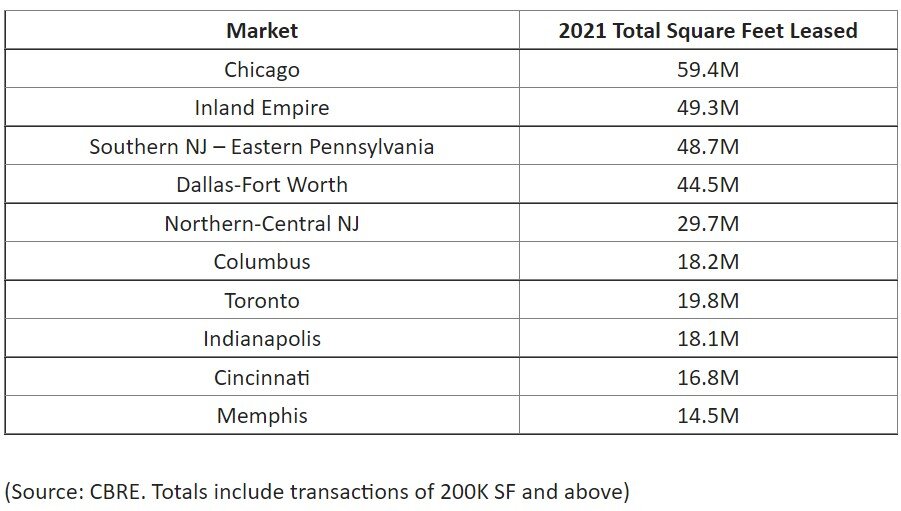Commercial Real Estate News

Big-Box Industrial Transactions in the U.S. Jump Dramatically in 2021
Commercial News » Dallas Edition | By David Barley | March 15, 2022 9:15 AM ET
According to new data from CBRE, retailers and wholesalers increased North American "big-box" warehouse transactions (200,000 sq. ft. or larger) dramatically in 2021, adding large amounts of additional merchandise to meet consumer demand and avoid future supply chain disruptions.
As retailers grappled with supply shortages in the early stages of the pandemic, new strategies emerged to hedge against future disruptions. The main course of action has been to increase domestic safety stock, which often requires taking more warehouse space to hold a greater amount of consumer products.
The result catapulted retailers and wholesalers to the top spot for big-box transactions, accounting for 35.8 percent of all activity, up considerably from 24.7 percent in 2020. This dethroned last year's leader, e-commerce only users, which fell to third at 10.7 percent (down from 27.1 percent). Third-party logistics remained in second place, expanding its share from 25.8 percent to 32.2 percent. Transactions include leases and user sales.
"Securing large warehouses has been a key strategy for retailers to navigate supply chain constraints," said John Morris, executive managing director and leader of CBRE's Americas Industrial & Logistics business. "In response, retailers have increased their inventory to meet demand for both in-store purchases and increasing e-commerce sales."
Overall Transaction Activity Soars
CBRE's report examined the 23 most dynamic big-box markets in the United States, Canada, and Mexico. In total, big-box transactions accounted for 450 million sq. ft. of activity in these markets, up 29 percent from 350 million sq. ft. in 2020.
Vacancy rates in this category fell to a record-low 3.4 percent, down from 4.6 percent in 2020. Four markets in the report are tracking vacancies at less than 1 percent, with Los Angeles the lowest at 0.2 percent. The tight market has driven average first-year rents to $6.03, up from $5.19 in 2020.
Morris explains, "With vacancy so tight, retailers need to plan several years ahead. If you need a large block of space quickly, odds are only a few, if any, will be available."
Additionally, construction completions were down slightly in 2021 at 186.7 million sq. ft., compared to 194.4 million sq. ft. the year prior. However, some relief may be found in the construction pipeline, which is at a record 323.9 million sq. ft.
Chicago led all markets with 59.4 million sq. ft. of transactions. Houston had the highest percentage of its inventory absorbed in 2021 (11.1 percent).
"Consistent construction completions will be essential for sustained transaction activity in 2022," said James Breeze, Global Head of Industrial & Logistics Research for CBRE. "The demand is there, but supply is extremely tight. If projects are delayed due to lack of materials or slow delivery from supply chain challenges, occupiers will find it difficult to make big moves."
Sign Up Free | The WPJ Weekly Newsletter
Relevant real estate news.
Actionable market intelligence.
Right to your inbox every week.
Real Estate Listings Showcase
Related News Stories
Commercial Real Estate Headlines
- One Trillion Dollars of America's Commercial Property Loans Mature in 2025
- U.S. West Coast Dominates Self Storage Demand
- Phoenix, Orange County and Inland Empire Emerge as Leading U.S. Industrial Markets
- U.S. Mega Distribution Centers Leasing Activity Grew in 2024
- U.S. Commercial Borrowing to Increase to $583 Billion in 2025, Up 16 Percent Annually
- Demand for U.S. Life Sciences Space Spikes 28 Percent Annually in Late 2024
- Multifamily Property Sector in America Rebounding
- Asia Pacific Commercial Property Investment Spikes 23 Percent in 2024
- U.S. Commercial Property Market Primed for Growth in 2025
- Architecture Industry Sees Mixed Signals as 2025 Approaches
- Global Data Center Demand Spikes in 2025
- 2025 Prediction: U.S. Commercial Investment Recovery Expected to Gain Traction
- Holiday Retail Sales for 2024 to Hit Record $1 Trillion
- Tech, AI Industries Drive Largest Share of Office Leasing Activity in U.S.
- Commercial Real Estate Lending in U.S. Enjoys Strong Growth in Q3
- U.S. Multifamily Market Begins Recovery in Q3
- Commercial Investment in Japan Spikes 24 Percent Annually in Q3
- Despite Return-to-Office Mandates, U.S. Office Vacancies Continue to Rise
- PROPSIG Tech Startup Acquired by World Property Data
- U.S. Commercial Mortgage Debt Hits $4.7 Trillion in Q2 as Delinquencies Increase
- Hong Kong Class A Office Rents Continue to Downtick in Mid-Summer
- U.S. Office Landlords Tenant Concessions Decline for First Time in 4 Years
- U.S. Commercial Mortgage Originations Spike 27 Percent in Q2 Over Q1
- Phnom Penh's Commercial Office, Retail Markets Face Slowdowns in 2024
- Global Edge Data Center Market to Hit $300 Billion by 2026
- Commercial Property Transactions in Japan Dive 25 Percent Annually in Q2
- Delinquency Rates for U.S. Commercial Property Loans Downticks in Q2
- Megawarehouse Lease Deals in U.S. Increase in 2024
- Office Tenants' Flight to Quality Buildings Increases in 2024
- Commercial Lending in Japan Upticks 6 Percent Annually in Q1
- AI Driving Significant Global Data Center Growth in 2024
- Total U.S. Commercial Mortgage Debt Rises to $4.7 Trillion in Q1
- U.S. Commercial Mortgage Delinquencies Rise in Early 2024
- Asia Pacific Office Sector to Further Reprice Throughout 2024
- U.S. Retail Foot Traffic to Surpass Pre-Pandemic Levels by 2025
- Commercial Real Estate Lending in U.S. Slowed in First Quarter
- Japan Commercial Property Investment Volume Jumps 7 Percent in Q1
- Asia Pacific Commercial Property Investment Leads the World, Spikes 13 Percent
- Driven by High Rates, U.S. Commercial Lending Imploded 47 Percent in 2023
- After Two Year Slump, Prime Multifamily Metrics Uptick in U.S.






